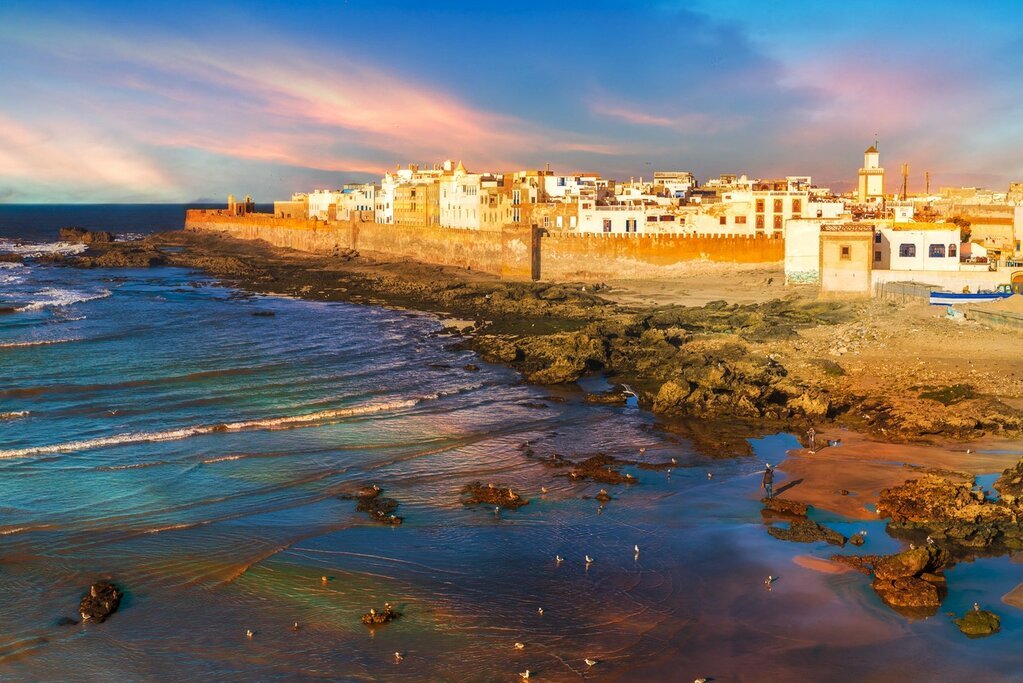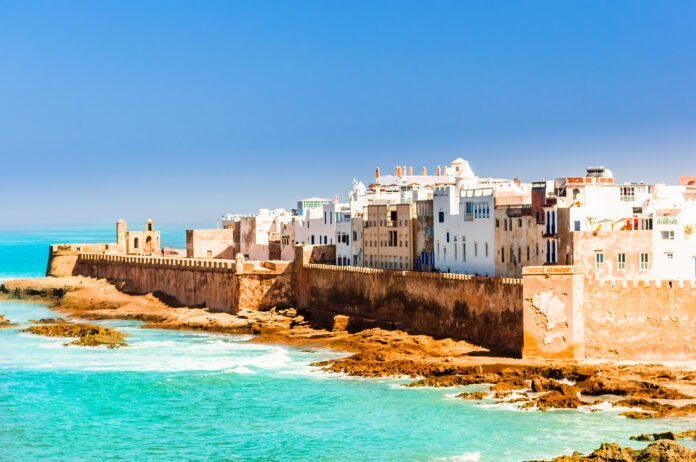Introduction
Essaouira: As I stepped off the plane in Marrakech, I could feel the excitement building inside me. I had long dreamed of visiting Morocco and exploring its contrasts – from the bustling souks of Marrakech to the tranquil coastal town of Essaouira. After a few pleasant days acclimating to the hustle and bustle of Marrakech, it was finally time for me to make the three-hour journey southwest to Essaouira.
As we drove closer to the coast, the landscape gradually transformed from arid plains to rolling hills dotted with argan trees. I started seeing glimpses of the azure Mediterranean in the distance between the mountains. Finally, as we crested one last hill, the entire panoramic vista of Essaouira Bay appeared before me – the beautiful Mediterranean waters cradled by sandy beaches on either side and the ochre-colored walled medina town nestled right at the water’s edge. It was a breathtaking sight that far surpassed any photo I had seen. I knew at that moment that I was going to fall in love with Essaouira.
Checking into my riad located right within the medina walls, I took some time to relax after the long journey. In the late afternoon, I ventured out to explore the small alleyways of the medina, taking in the sights, sounds, and smells. The sandy streets were bustling yet tranquil, with locals and tourists going about their activities. Music from local Gnawa bands drifted through the air.
Intricately carved wooden doors and balconies of the beautiful traditional Moroccan homes lining the alleyways beckoned me to peek inside their inner courtyards. Colorful displays of spices, fabrics, and pottery drew me into the lively souks. I ended up at the tranquil Mediterranean shore as the sun dipped into the ocean, mesmerized by the scenic beauty. It was the perfect beginning to my Essaouira experience.
Over the next few days, I set out to discover more of what makes Essaouira so unique – from its rich history and cultural influences to its thriving local art scene nestled between its ancient walls. Read on to learn more about the coastal charms that make Essaouira an enduringly tranquil yet vibrant destination.
Essaouira: A Glimpse into Essaouira’s Past and Cultural Influences
Essaouira’s history spans centuries, shaped by the many civilizations and peoples that have called this coastal townhome. Situated on the continent’s edge looking out to Europe, Essaouira has long served as an essential commercial outpost facing the sea routes. Archaeological findings in the area date human settlement back to Phoenician times in the first millennium BC. Under the rule of various Berber dynasties, Essaouira flourished as a key port town for trade with Europe and Africa.
In the 18th century, Sultan Sidi Mohammed ben Abdullah commissioned the construction of the current walled medina town as a well-planned fortified city. He invited settlers of various backgrounds, including Muslims from North and Sub-Saharan Africa, as well as Jews from Europe and the Middle East. This created a unique cultural melting pot, with influences of Andalusian, Berber, Arabic, African, and European traditions blending. The medina’s layout, with four gated entrances facing the four points of the compass, is attributed to the French architects who assisted in its construction.
Walking through the medina streets today, one can see the architectural influences of Moroccan, Andalusian, and Portuguese styles blended harmoniously in the ornate wooden doors, carved stuccowork, and whitewashed houses. The cultural diversity is also reflected in Essaouira’s local musical traditions – the blend of Gnawa (African rhythms), Arabic, and Andalusian styles creating a distinct sound epitomized by the brilliant masters of Essaouira Gnawa music who continue performing for locals and visitors alike.
Similarly, the medina’s elaborate assortment of spices from around the continent in vibrant souk displays is a legacy of its past as a trading hub. With Jews and Christians living alongside Muslims back then, culturally diverse festivities and celebrations also shaped the town’s identity. The remnants of a historic Jewish quarter within the medina walls are evidence of that rich, multi-faith history. Walking through the labyrinthine alleyways today, one can’t help but feel transported back to a time when people of different origins co-existed harmoniously in this seaside town at the cusp of three continents.
Essaouira: Art and Culture Blooming Between the Ancient Walls
The old aphorism “Necessity is the mother of invention” rings especially true for Essaouira. Having long relied on fishing and trade for livelihoods, the resourceful locals nurtured thriving artisan crafts that have bloomed into a significant contributor to Essaouira’s creative economy and cultural identity.
Woodcarving is one of the medina’s finest artistic traditions, possibly dating back to its shipbuilding roots. Expert artisans produce exquisitely crafted pieces from thuya and cedar wood – from functional items like chests, doors, and furniture to fanciful figurines and decorative items. The carpenters’ sophisticated techniques have been passed down through generations.
Thriving weaving and textile cooperatives across town keep alive the centuries-old knitting, embroidery, and crafting skills from local materials like wool, linen, and camel wool. Vibrantly patterned shawls, cushion covers, and traditional Berber-style rugs line shelves alongside more modern designs.
Another iconic Essaouiran craft is the intricate inlay art known as ‘menuiserie marquetry.’ Intricate marquetry designs are created by inlaying stained thuya, ebony, and olive woods into furniture and boxes to form elaborate patterns. The meticulous skill and patience required result in breathtakingly beautiful artwork.
Since the 1970s, Essaouira has also developed into an artistic hub attracting painters, sculptors, musicians, and creative spirits from across the globe. Residents and visiting artists have contributed to a lively art scene inspired by the scenic natural surroundings and historic culture. Galleries exhibiting works in diverse mediums dot the medina alleys alongside workshops where visitors can interact with artists at work. Major annual cultural festivals like ‘Essaouira Gnaoua & World Music Festival’ and ‘Les Semailles further enhance the cultural vibrancy.
Essaouira artisans continue breathing new life into their inherited skills with each generation while inviting the world to share in their traditions. Walking through this artistically thriving medina is like traversing through a living museum – from seeing craftspeople at work to admiring the finished pieces that narrate stories through their intricacies. It is a unique experience to interact with the warm, welcoming artists and artisans who are keeping these age-old cultural heritages alive.

Essaouira: Revelling in Nature’s Beauty Along Essaouira’s Shores
While strolling along the breezy coastal corniche promenade, one cannot help but be mesmerized by the azure expanse of the Mediterranean waters lapping softly at the shore. Time seems to slow down as you watch fishing boats bobbing gently on the waves alongside seagulls soaring overhead. The sandy stretch extends invitingly towards calm surf, beckoning you for a refreshing swim. In the distance, jagged volcanic islands dot the horizon, and Europe seems almost within reach across the water.
It is not difficult to understand why Essaouira’s scenic location along Morocco’s Atlantic coastline has long drawn travelers seeking tranquility. Away from the hubbub of cities, one feels an inherent calmness pervading this seaside town in harmony with nature’s rhythms. Wandering the empty beaches in the off-season allows for connecting deeply with the elements and inner peace. Colorful fishing boats pulled up on shore; fishing nets spread out to dry as reminders of local livelihoods intrinsically linked to the bountiful sea.
A short drive north leads to the craggy coastal stretch around the fishing village of Mogador. Jagged cliffs plunge dramatically into deep emerald waters, concealing hidden coves and islets. Hiking trails wind along the scenic coast, rewarding hikers with panoramic vistas. Whales, dolphins, and seabirds can often be spotted frolicking in the waters. Peeking into rock pools, one discovers a miniature living world of anemones, sea urchins, and starfish. The rugged beauty of the Atlantic coast evokes a sense of raw natural majesty.
Inland, the UNESCO Biosphere Reserve of Souss-Massa National Park lies a short drive from Essaouira, protecting diverse ecosystems from coastal and marine habitats to inland forests and agricultural fields. Trekking, birdwatching, and camping opportunities allow for immersing in natural splendors. Come spring; the park bursts into a riot of wildflowers carpeting open landscapes with touches of orange, yellow, and purple.

